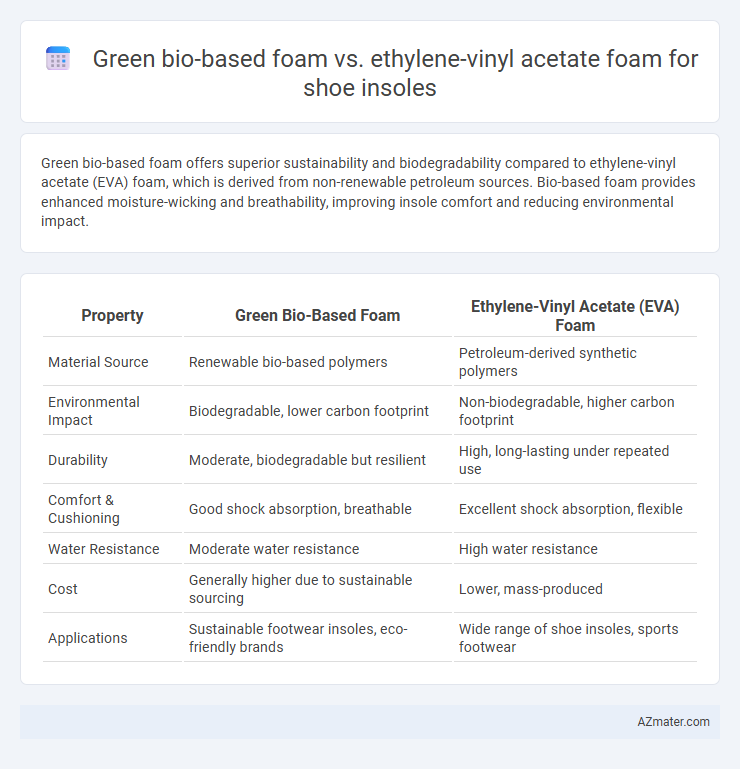Green bio-based foam offers superior sustainability and biodegradability compared to ethylene-vinyl acetate (EVA) foam, which is derived from non-renewable petroleum sources. Bio-based foam provides enhanced moisture-wicking and breathability, improving insole comfort and reducing environmental impact.
Table of Comparison
| Property | Green Bio-Based Foam | Ethylene-Vinyl Acetate (EVA) Foam |
|---|---|---|
| Material Source | Renewable bio-based polymers | Petroleum-derived synthetic polymers |
| Environmental Impact | Biodegradable, lower carbon footprint | Non-biodegradable, higher carbon footprint |
| Durability | Moderate, biodegradable but resilient | High, long-lasting under repeated use |
| Comfort & Cushioning | Good shock absorption, breathable | Excellent shock absorption, flexible |
| Water Resistance | Moderate water resistance | High water resistance |
| Cost | Generally higher due to sustainable sourcing | Lower, mass-produced |
| Applications | Sustainable footwear insoles, eco-friendly brands | Wide range of shoe insoles, sports footwear |
Introduction to Shoe Insole Materials
Shoe insoles commonly utilize materials like green bio-based foam and ethylene-vinyl acetate (EVA) foam, each offering distinct cushioning and support properties. Green bio-based foam is derived from renewable resources such as plant oils, providing enhanced sustainability and biodegradability compared to conventional EVA foam. EVA foam remains popular due to its lightweight nature, excellent shock absorption, and durability, making it a standard choice for a wide range of footwear applications.
Overview of Green Bio-based Foam
Green bio-based foam for shoe insoles is derived from renewable plant resources, offering enhanced biodegradability and reduced environmental impact compared to conventional ethylene-vinyl acetate (EVA) foam. This material provides comparable cushioning and flexibility while significantly lowering carbon footprint and reliance on fossil fuels. Its sustainable composition supports eco-friendly footwear manufacturing, aligning with increasing consumer demand for green products.
Ethylene-vinyl Acetate Foam: Properties and Uses
Ethylene-vinyl acetate (EVA) foam is widely used in shoe insoles due to its excellent flexibility, lightweight nature, and superior shock absorption capabilities. This polymer foam offers high resilience, good abrasion resistance, and cushioning, making it ideal for athletic and casual footwear aimed at comfort and durability. Its ability to maintain shape under compression and resist moisture enhances foot support and reduces fatigue during extended wear.
Environmental Impact Comparison
Green bio-based foam, derived from renewable resources like plant oils or starch, significantly reduces carbon footprint and minimizes reliance on fossil fuels compared to Ethylene-vinyl acetate (EVA) foam, which is petroleum-based and contributes to greenhouse gas emissions during production. Green bio-based foam offers enhanced biodegradability and compostability, decreasing landfill accumulation and microplastic pollution linked with traditional EVA insoles. The sustainable sourcing and lower toxicity of green bio-based materials support circular economy principles, making them a more environmentally responsible choice for shoe insole manufacturing.
Comfort and Performance Analysis
Green bio-based foam insoles provide superior breathability and moisture-wicking properties compared to Ethylene-vinyl acetate (EVA) foam, enhancing overall foot comfort during extended wear. The natural composition of bio-based foam offers better shock absorption and cushioning, reducing foot fatigue and improving ergonomic support for athletic and casual footwear. EVA foam excels in durability and flexibility but often lacks the environmental sustainability and enhanced thermal regulation found in green bio-based alternatives, impacting long-term comfort and performance.
Durability and Longevity Assessment
Green bio-based foam exhibits superior biodegradability while maintaining competitive durability compared to Ethylene-vinyl acetate (EVA) foam, which is known for its resilience and flexibility in shoe insoles. Long-term wear tests reveal that EVA foam typically retains its cushioning properties and structural integrity for a longer period under repetitive stress and moisture exposure. However, advancements in bio-based foam formulations are increasingly enhancing their lifespan, making them a sustainable alternative without significant compromise on insole durability and longevity.
Cost Efficiency: Production and Retail
Green bio-based foam offers improved cost efficiency in shoe insole production due to the use of renewable raw materials, reducing dependence on petroleum-based inputs and mitigating long-term price volatility. Ethylene-vinyl acetate (EVA) foam benefits from well-established manufacturing processes and economies of scale, leading to lower immediate production costs and widespread retail availability. However, rising environmental regulations and consumer demand for sustainable products increasingly favor green bio-based foam, potentially enhancing its market value and retail profitability.
Consumer Health and Safety
Green bio-based foam insoles provide enhanced breathability and reduced chemical exposure compared to ethylene-vinyl acetate (EVA) foam, promoting better foot health and reducing risk of skin irritation. Bio-based foams often contain fewer volatile organic compounds (VOCs) and toxic additives, making them safer for sensitive skin and long-term use. In contrast, EVA foam may release low levels of VOCs and contain additives linked to allergic reactions or environmental concerns, impacting overall consumer safety.
Market Trends in Sustainable Footwear
Green bio-based foam is rapidly gaining traction in the sustainable footwear market due to its renewable raw materials, biodegradability, and reduced carbon footprint compared to traditional Ethylene-vinyl acetate (EVA) foam. Market trends highlight increased consumer demand for eco-friendly shoe insoles, driving innovation in bio-based materials like castor oil and algae-derived foams that maintain cushioning and durability standards. The shift towards circular economy principles and stricter environmental regulations is accelerating the adoption of green bio-based insoles, positioning them as a pivotal element in the future of sustainable footwear.
Future Prospects for Insole Material Innovation
Green bio-based foams offer sustainable advantages by utilizing renewable raw materials such as plant oils and natural polymers, reducing environmental impact compared to traditional ethylene-vinyl acetate (EVA) foam derived from petrochemicals. Innovations in bio-based foam technology focus on enhancing durability, cushioning, and moisture-wicking properties to meet or exceed EVA performance standards. Future prospects in shoe insole materials emphasize eco-friendly formulations with improved biodegradability and lifecycle sustainability, appealing to environmentally conscious consumers and manufacturers.

Infographic: Green bio-based foam vs Ethylene-vinyl acetate foam for Shoe insole
 azmater.com
azmater.com